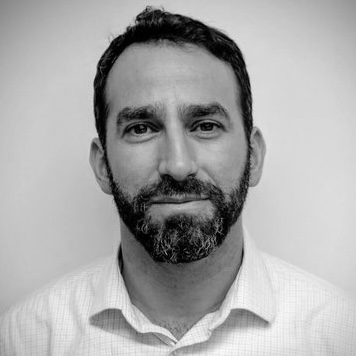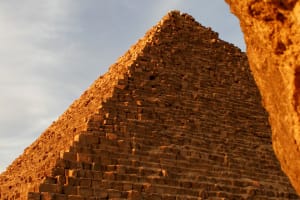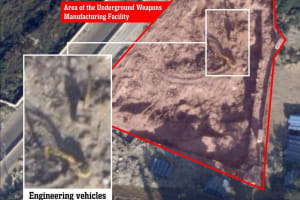Scrubbed by the Times: NY Times routinely erases extremism from “pro-Palestinian protests”

The extremism is a pattern. So is the New York Times’ commitment to concealing it.
This week in Manhattan, Brooklyn, Los Angeles, and Washington, D.C., anti-Israel activists wished for Hitler’s return; chanted for the murder of “Zionists”; assaulted, threatened to kill, and slurred a rabbi; threatened a Jewish family by painting a symbol of Hamas violence on their home; held banners supporting the terror group behind the Oct. 7 massacre; donned the headbands of the terrorists; waved their flags; glorified their “resistance” broadly; justified the murders at the music festival specifically; smashed and bloodied the face of a security guard; and downplayed the Holocaust.
The New York Times covered each of the “protests” where the ugly episodes occurred. But it hid each one of incidents, as well as other examples of the demonstrators’ extremism.
Washington, D.C.
At a June 8 demonstration in Washington, D.C., a group of demonstrators, faces covered with keffiyehs, held a large banner aligning themselves with “al Qassam,” a reference to Hamas’s gunmen who led the Oct. 7 attack. They called for murder: “Hezbollah make us proud, kill another Zionist now!”
A man holding a “Stand with Hamas” sign defended the October 7 slaughter as “brilliant” while decrying what “the Jews—yeah, the Jews” are doing to the Palestinians. Another sign justified “resistance.”
The Times, whose article on the demonstration cast them as little more than a “call for an immediate cease-fire,” said nothing about the celebration of terrorist groups, the explicit calls for “killing,” or the defense of Oct. 7.
‘Free Palestine’ protestors are demonstrating against the White House, calling for the murder of Zionists (i.e. most Jews).
— Ritchie Torres (@RitchieTorres) June 8, 2024
When you live in a political culture that systematically dehumanizes “Zionists,” the eventual outgrowth of dehumanization is violence. History tells us… pic.twitter.com/g8Knc1MGbc
Statues in D.C.’s Lafayette Square were vandalized with pro-violence and eliminationist graffiti. “Glory 2 the resistance.” “Long live Hamas.” “Intifada.” “From the river to the sea.” “Death to Amerikkka.” And plenty of upside-down red triangles, the symbol used in Hamas propaganda videos to mark targets for violent attack.
The New York Times referred only to “handwritten scribbles” that read “free Palestine.”

Men wearing the headbands of Hamas and PFLP, designated terrorist groups known for their suicide bombing attacks on Jewish civilians, shouted, “There is only one solution, intifada revolution!”
The newspaper disingenuously steered readers to believe the calls were more or less innocuous:
Many of the protesters on Saturday chanted slogans that some groups have said incite violence against Jews, such as “There is only one solution: intifada, revolution,” as well as “From the river to the sea, Palestine will be free.”
But according to one protester, such slogans were not a call for violence against Jewish people, but for a broader resistance against the status quo.
DC: Protester holds up a bloody mask depicting President Joe Biden. Another protester burns American flag behind him as statue is sprayed with "FJB" outside of the White House during Pro-palestine protest.
— Oliya Scootercaster 🛴 (@ScooterCasterNY) June 8, 2024
Video by @yyeeaahhhboiii2 Desk@freedomnews.tv to license pic.twitter.com/viHOfVToDq
The gathering was co-organized by the Palestinian Youth Movement, a group that responded to the Oct. 7 attacks, on the day of the attacks, with celebratory “long live the resistance” calls, and which had previously called for “resistance and intifada until victory.” (The group has made clear that victory, to them, means the elimination of Israel.)
The New York Times absurdly characterized it as a “left-leaning” group.
Palestine youth movement was organizing rallies in support of the slaughter of innocent civilians while the blood hadn’t even dried yet pic.twitter.com/1DT67PMMQq
— ~Jachnun Supremacist~ נפתלי בן מתתיהו (@JachnunEmpire) October 20, 2023
Although video from the demonstrations showed demonstrators throwing objects at a park ranger and punching park police, the story had failed to mention this, even while noting in the first paragraph that police used pepper spray on a protester.
(Two days after the piece was published, the paper did add a statement from the National Park Service noting “an assault of a park ranger” and “injuries to two U.S. Park Police officers.” According to the reporters, the statement described empty water bottles being thrown at the park ranger. Fuller versions of what appeared to be the same statement, published elsewhere, made no reference to empty bottles.
Manhattan
On June 10, the extremist group Within Our Lifetime, which supports the Oct. 7 massacre, organized a demonstration in Manhattan.
At Union Square, a man told counter-protesters, “I wish Hitler was still here, he would’ve wiped all you out.” Other demonstrators unfurled a large banner reading, “Long live October 7th.”
“I wish H*tler was still here, he would’ve wiped you all out,” man tells Jews in Union Square during “Day of Rage” protests pic.twitter.com/qOwDXQEIyu
— Luke Tress (@luketress) June 11, 2024
#NOW Protesters unfurl banner that reads "Long Live October 7th" in Union Square NYC pic.twitter.com/UH82UL92Vf
— Oliya Scootercaster 🛴 (@ScooterCasterNY) June 10, 2024
After a mass subway ride, during which demonstrators insisted “Zionists” identify themselves and insinuated harm would come to them if they didn’t leave the train, demonstrators converged on Wall Street, where they waved the flag of the group behind the Oct. 7 massacre and that of another terrorist organization.
They came to protest an exhibit memorializing the hundreds of civilians murdered by Hamas at the Nova Music Festival, to justify the murders, and to minimize the Holocaust by claiming the kids gunned down at the festival were worse than the commandant of the Auschwitz extermination camp.
Anti-Israel bigots are protesting the Nova Music Festival Exhibition, which seeks to commemorate the lives of the hundreds of young Jews barbarically murdered by Hamas on October 7th.
— Ritchie Torres (@RitchieTorres) June 11, 2024
These bigots deny the massacre at the Nova Music Festival, calling it “Zionist propaganda.”… pic.twitter.com/8eD9lZXPr0
The New York Times initially ignored the hate fest. A day later, after members of Congress, the mayor of New York City, and the White House condemned the rally and its antisemitism, the paper did report on the condemnation.
But the piece said nothing about the pro-Hitler language, and nothing about the terrorist flags. (The paper was surely aware of the flags. It quoted from of White House statement that criticized the flying of “profane banners of terrorist organizations,” but ignored that line. And quoted from a statement in which the NYC mayor criticized the terror flags, but ignored that line.)
And while the story did refer to demonstrators shouting “long live the intifada” — the call for violence that the paper had previously suggested might not be a call for violence — it didn’t quote those same demonstrators’ chant that “resistance is justified,” a defense of the Oct. 7 massacre that, while sickening on its own, also underscored the true meaning of their intifada calls.
Brooklyn
Two days later, vandals smeared paint on the homes of the director of the Brooklyn Museum and two of its trustees. On the home of the director, who is Jewish, they painted the upside-down red triangle that symbolizes a Hamas target, a menacing threat of violence.
The newspaper’s story about the graffiti did not mention the Hamas triangle. (It can be seen in a photo on the online piece, but the caption and the story itself said nothing of the symbol, let alone what it means.)
U.C.L.A.
On the other side of the country, demonstrators gathered at the University of California, Los Angeles.
As the school’s Chabad rabbi recorded video of the event, a demonstrator wearing a checkered headscarf smacked the phone out of his hand, threatened to kill him, slurred him as a pedophile, and called for “death to Israel and anyone who supports that shit.” Another demonstrator told him to “go back to Poland.”
The New York Times covered the rally. It said nothing about the antisemitic incident or death threats.
🚨WARNING: DISTURBING CONTENT (Updated video)
— Stephanie🕊 (@stephsvox) June 11, 2024
RABBI PHYSICALLY & VERBALLY ATTACKED WHILE LIVESTREAMING @UCLA (6/10/24)
The slurs yelled at Chabad House Director Rabbi Dovid Gurevich are deeply offensive, explicit, and include descriptions of pedophilia. This was livestreamed… pic.twitter.com/pTS7Z6HScP
Elsewhere on campus, a security guard was battered in the face and bloodied with a hard object. The paper — of course — said nothing about this violence. (The piece did, however, twice make a point of referencing aggression by pro-Israel protesters from months ago.)
🧵 Violence at UCLA again yesterday.
— Steve McGuire (@sfmcguire79) June 11, 2024
Protestors assaulted and harassed multiple people: a rabbi, a journalist, a security guard, and a vice chancellor.
First, the security guard was hit with what appears to be a smartphone: pic.twitter.com/WMcZlWyF6P
This week’s stories, in which the New York Times manages to erase vile extremism from four separate demonstrations, are hardly the first example of the paper coming to the aid of anti-Israel extremists. It had previously come to the aid of those tearing down posters of Israeli hostages by suggesting this was perhaps just a “release valve” for the “anguished,” while giving equal weight to the idea that those putting up the posters might be the real problem. Another piece absurdly suggested that calls for a Palestine “from the river to the sea” did not necessarily refer to a Palestine from the river to the sea.
This article originally appeared here and is reposted with permission.

Gilead Ini is a Senior Research Analyst at CAMERA. His commentary has appeared in numerous publications, including the Jerusalem Post, Christian Science Monitor, Columbia Journalism Review and Commentary, and has been featured on national and international radio programs. He has lectured widely on media coverage of the Arab-Israeli conflict. Ini is co-author of the monograph "Indicting Israel: New York Times Coverage of the Palestinian-Israeli Conflict." On Twitter: http://twitter.com/GileadIni














